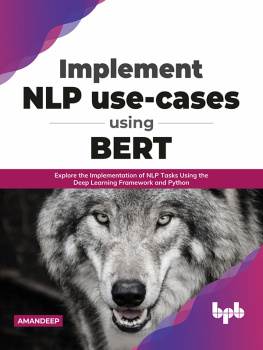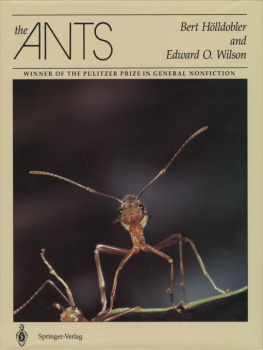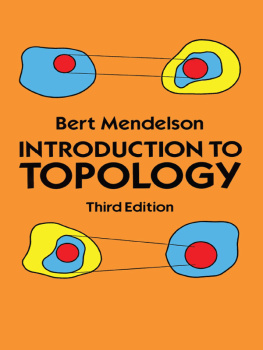Amandeep - Implement NLP use-cases using BERT
Here you can read online Amandeep - Implement NLP use-cases using BERT full text of the book (entire story) in english for free. Download pdf and epub, get meaning, cover and reviews about this ebook. year: 2021, publisher: BPB Publications, genre: Home and family. Description of the work, (preface) as well as reviews are available. Best literature library LitArk.com created for fans of good reading and offers a wide selection of genres:
Romance novel
Science fiction
Adventure
Detective
Science
History
Home and family
Prose
Art
Politics
Computer
Non-fiction
Religion
Business
Children
Humor
Choose a favorite category and find really read worthwhile books. Enjoy immersion in the world of imagination, feel the emotions of the characters or learn something new for yourself, make an fascinating discovery.
- Book:Implement NLP use-cases using BERT
- Author:
- Publisher:BPB Publications
- Genre:
- Year:2021
- Rating:5 / 5
- Favourites:Add to favourites
- Your mark:
- 100
- 1
- 2
- 3
- 4
- 5
Implement NLP use-cases using BERT: summary, description and annotation
We offer to read an annotation, description, summary or preface (depends on what the author of the book "Implement NLP use-cases using BERT" wrote himself). If you haven't found the necessary information about the book — write in the comments, we will try to find it.
Implement NLP use-cases using BERT — read online for free the complete book (whole text) full work
Below is the text of the book, divided by pages. System saving the place of the last page read, allows you to conveniently read the book "Implement NLP use-cases using BERT" online for free, without having to search again every time where you left off. Put a bookmark, and you can go to the page where you finished reading at any time.
Font size:
Interval:
Bookmark:

NLP Use-cases
Using BERT

NLP Tasks Using the Deep Learning
Framework and Python


www.bpbonline.com
FIRST EDITION 2021
Copyright BPB Publications, India
ISBN: 978-93-90684-625
All Rights Reserved. No part of this publication may be reproduced, distributed or transmitted in any form or by any means or stored in a database or retrieval system, without the prior written permission of the publisher with the exception to the program listings which may be entered, stored and executed in a computer system, but they can not be reproduced by the means of publication, photocopy, recording, or by any electronic and mechanical means.
LIMITS OF LIABILITY AND DISCLAIMER OF WARRANTY
The information contained in this book is true to correct and the best of authors and publishers knowledge. The author has made every effort to ensure the accuracy of these publications, but publisher cannot be held responsible for any loss or damage arising from any information in this book.
All trademarks referred to in the book are acknowledged as properties of their respective owners but BPB Publications cannot guarantee the accuracy of this information.
Distributors:
BPB PUBLICATIONS
20, Ansari Road, Darya Ganj
New Delhi-110002
Ph: 23254990/23254991
MICRO MEDIA
Shop No. 5, Mahendra Chambers,
150 DN Rd. Next to Capital Cinema,
V.T. (C.S.T.) Station, MUMBAI-400 001
Ph: 22078296/22078297
DECCAN AGENCIES
4-3-329, Bank Street,
Hyderabad-500195
Ph: 24756967/24756400
BPB BOOK CENTRE
376 Old Lajpat Rai Market,
Delhi-110006
Ph: 23861747

Published by Manish Jain for BPB Publications, 20 Ansari Road, Darya Ganj, New Delhi-110002 and Printed by him at Repro India Ltd, Mumbai
www.bpbonline.com
My beloved Parents
and
Siblings
for their continuous guidance, support,
encouragement, understanding, and
faith in my efforts.
Amandeep was working as a technical lead in the field of software development at the time of publishing this book. He has worked for almost eight years in a few of the top MNCs. He has a wide horizon of interests in coding in Java and Python with an inclination in deep learning. He has worked in numerous data science fields, especially Natural Language Processing. He completed his master's degree with a specialization in Data Analytics from the Birla Institute of Technology and Science, Pilani. He has reviewed a few research papers under IEEE Transactions on Neural Networks and Learning Systems. He has earned certifications from multiple MOOCs on data science, machine learning, deep learning, image processing, natural language processing, artificial intelligence, algorithms, statistics, mathematics, and other related courses.
Dr. Syed Hassan Amin has done PhD in Computer Science from Imperial College London, United Kingdom and MS in Computer System Engineering from GIKI, Pakistan. He has worked on Image Processing, Computer Vision, Databases, Business Intelligence and Data Science.
In his current role, Dr. Hassan Amin has been working as Director Technology at i2c inc since 2017. He has been involved in designing/developing business intelligence solution, and developing organizational capacity for building data science solutions. He has also been involved in guiding solutions for payment fraud, and other applications of data science in payment processing industry. He is a passionate data scientist, teacher, developer and is actively involved in data science discussions and competitions on Kaggle.
Ojasvi Mehta is a doctoral candidate in the School of Medicine at the University of Nottingham, UK. Her research concerns investigating the role of the microbiome in human health and diseases. She had studied Bioinformatics for her masters degree and Biotechnology for her under graduation. She has worked as Research Assistant for two years at the Indian Council of Medical Research, New Delhi where she skilled in scientific documentation and funds management. She holds an enthusiasm for helping mankind through science and that made her work as Research Fellow for over five years as a molecular geneticist at Translational Health Sciences and Technology Institute, Faridabad which is a Department of Biotechnology-funded Institute. After researching molecular genetics Ojasvi intends to shift the paradigm of her interest back to computational and in-silico analysis. Her research interest revolves around data analysis of the high throughput 'omics' data using tools for sequence analysis and statistical inferences implying biostatistics, deep learning and NLP. She has contributed to over seven scientific publications as authors in peer-reviewed journals and has been awarded travel awards to present her work at international conferences.
Writing a book on any topic that is understood very well by beginners requires immense effort. The writing process is similar to passing through a tunnel, where it is dark but when you pass through, you see a valley full of beautiful flowers. This book has given me a similar feeling for which I am very grateful to my parents and siblings for being patient and supporting me during this journey.
My gratitude also goes to the team at BPB Publications for being supportive enough to provide me enough time to finish the first part of the book and also allow me to publish the book in multiple parts, since Natural Language Processing, being a vast and very active area of research, it was impossible to explain classes and types of problems in a single book, especially by not making it too voluminous.
This book covers many different aspects of natural language processing through a brief description of different types of problems starting from text classification to the recent advancements in text analytics with machine learning and deep learning models. The key focus is to set a strong foundation for NLP understanding and then finally leverage the state-of-the-art general-purpose language model named BERT developed by Google. This book describes the theoretical concepts required to solve a problem and talks a little about the mathematical perspective as well to make it easy for the reader to understand. It also provides some cutting-edge solutions to a few advanced problems where we have limited tagged data and a trained model comes as a blessing in disguise.
The primary goal of this book is for anyone looking to develop the fundamental concepts in natural language processing and explore more advanced problems. Typical target readers will be NLP developers who want to learn how to write code in Python to solve some typical text problems using BERT. The reader should have some knowledge of Python as a programming language and some programming experience. Also, it will be good for the reader to have some basic knowledge about natural language processing (though not mandatory) in computers and some basic math background.
Font size:
Interval:
Bookmark:
Similar books «Implement NLP use-cases using BERT»
Look at similar books to Implement NLP use-cases using BERT. We have selected literature similar in name and meaning in the hope of providing readers with more options to find new, interesting, not yet read works.
Discussion, reviews of the book Implement NLP use-cases using BERT and just readers' own opinions. Leave your comments, write what you think about the work, its meaning or the main characters. Specify what exactly you liked and what you didn't like, and why you think so.










